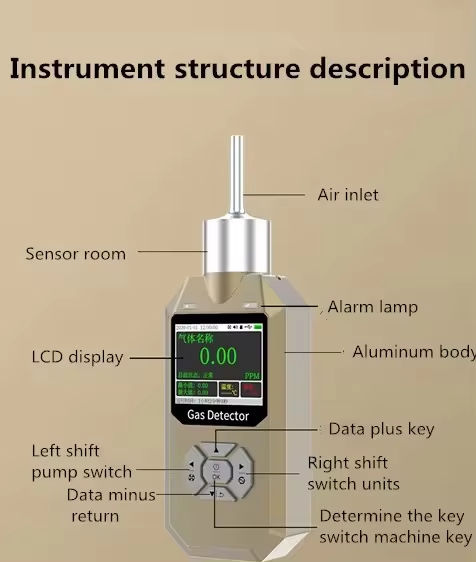Data: 7 de febreiro de 2025
Localización: Alemaña
No corazón de Europa, Alemaña é recoñecida desde hai tempo como unha potencia da innovación e a eficiencia industrial. Desde a fabricación de automóbiles ata a farmacéutica, as industrias do país caracterízanse polo compromiso coa calidade e a seguridade. Un dos últimos avances que está a causar sensación en varios sectores é o detector intelixente de fósforo gasoso (PH3). A medida que as industrias dependen cada vez máis dos procesos químicos, non se pode esaxerar a importancia da monitorización en tempo real de gases perigosos como a fosfina (PH3).
Comprender a fosfina e os seus riscos
A fosfina é un gas altamente tóxico que se emprega habitualmente en aplicacións agrícolas e industriais, principalmente como pesticida e fumigante en almacéns de grans e outros produtos almacenados. Aínda que é eficaz, a súa natureza perigosa supón riscos significativos para os traballadores e o medio ambiente. A exposición prolongada pode provocar graves problemas de saúde, como insuficiencia respiratoria e outras afeccións críticas. Por iso, a implementación de sistemas de monitorización avanzados converteuse en esencial para garantir a seguridade no lugar de traballo e o cumprimento da normativa.
Detectores intelixentes de PH3: un avance tecnolóxico
Tradicionalmente, os sistemas de detección de gases funcionaban con mecanismos de aviso sinxelos, alertando ao persoal só cando se alcanzaban niveis perigosos. Non obstante, os detectores intelixentes de fósforo gasoso máis recentes empregan tecnoloxía avanzada, incluíndo intelixencia artificial e algoritmos de aprendizaxe automática, para proporcionar unha solución de monitorización integral.
Estes detectores de última xeración analizan continuamente a calidade do aire, o que permite ás empresas:
-
Recibir alertas en tempo realOs detectores intelixentes notifican inmediatamente aos traballadores e á dirección o aumento dos niveis de fosfina, o que permite tomar medidas rápidas para mitigar os riscos.
-
Análise preditivaCon capacidades de aprendizaxe automática integradas, estes detectores poden analizar datos históricos para prever posibles perigos, mellorando significativamente os protocolos de seguridade.
-
Monitorización remotaMoitos detectores modernos están equipados con conectividade IoT, o que permite o acceso remoto aos datos e a monitorización a través de teléfonos intelixentes ou ordenadores. Esta característica é especialmente vantaxosa para instalacións grandes con varias localizacións.
-
Rexistro de datos e cumprimentoOs sensores manteñen rexistros exhaustivos dos niveis de gas ao longo do tempo, o que axuda ás industrias a demostrar o cumprimento das estritas normas de seguridade e os estándares ambientais alemáns.
Impacto nas industrias alemás
A introdución de detectores intelixentes PH3 está a transformar varios sectores clave da economía alemá:
-
Sector agrícolaAlemaña segue sendo un dos principais produtores agrícolas de Europa, e a fosfina úsase a miúdo no almacenamento e transporte de grans. Os detectores intelixentes non só melloran a seguridade dos traballadores, senón que tamén garanten que se manteña a calidade dos produtos almacenados, minimizando as perdas causadas pola contaminación.
-
Fabricación de produtos químicosPara as empresas que se dedican á produción de produtos químicos, as estritas normativas sobre substancias perigosas requiren unha monitorización continua. Os detectores intelixentes de PH3 permiten aos fabricantes cumprir os requisitos de conformidade, ao tempo que proporcionan un ambiente de traballo máis seguro.
-
Produtos farmacéuticosNa industria farmacéutica, onde a precisión e a seguridade son primordiais, os detectores de gas intelixentes axudan a manter unhas condicións de traballo óptimas. Isto é crucial para protexer os traballadores que manipulan diversos produtos químicos, incluídos aqueles que poden producir fosfina como subproduto.
-
Protección ambientalMentres Alemaña continúa a facer fincapé na sustentabilidade e a responsabilidade ambiental, o uso de detectores intelixentes de PH3 aliñase co compromiso do país de reducir os riscos químicos e garantir un medio ambiente máis limpo.
Desafíos e perspectivas de futuro
Malia as claras vantaxes, a adopción de detectores intelixentes de fósforo gasoso non está exenta de desafíos. Os custos de investimento iniciais poden ser substanciais, especialmente para as pequenas e medianas empresas (PEME) que operan con orzamentos axustados. Non obstante, o aforro a longo prazo derivado da redución dos riscos para a saúde, o aumento da eficiencia dos traballadores e o cumprimento das normas de seguridade adoitan superar estes custos iniciais.
A medida que a tecnoloxía continúa evolucionando, espérase que as futuras versións dos detectores PH3 sexan aínda máis sofisticadas. As innovacións na tecnoloxía de sensores, a análise de datos e a integración cos sistemas de seguridade existentes probablemente mellorarán a eficiencia operativa e as medidas de seguridade en diversas industrias.
Conclusión
O detector intelixente de fósforo gasoso (PH3) representa un avance crucial para garantir a seguridade na industria alemá. Ao monitorizar de forma proactiva os niveis de gases perigosos, estes sofisticados dispositivos non só protexen os traballadores, senón que tamén melloran a eficiencia operativa e o cumprimento das normativas. A medida que as industrias alemás continúan a esforzarse pola innovación e a seguridade, o detector intelixente PH3 constitúe un testemuño da importancia de investir en tecnoloxía que priorice a saúde e a xestión ambiental. Nun país sinónimo de excelencia na enxeñaría, adoptar estes avances reafirma o compromiso de Alemaña cun futuro industrial máis seguro e responsable.
Para obter máis información sobre os sensores de gas,
Póñase en contacto con Honde Technology Co., LTD.
Email: info@hondetech.com
Sitio web da empresa: www.hondetechco.com
Data de publicación: 07-02-2025


